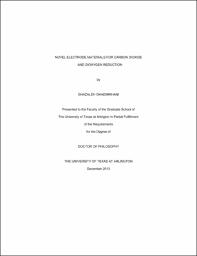
ATTENTION: The works hosted here are being migrated to a new repository that will consolidate resources, improve discoverability, and better show UTA's research impact on the global community. We will update authors as the migration progresses. Please see MavMatrix for more information.
Show simple item record
| dc.contributor.advisor | Rajeshwar, Krishnan | |
| dc.contributor.author | Ghadimkhani, Ghazaleh | |
| dc.date.accessioned | 2019-09-09T19:40:18Z | |
| dc.date.available | 2019-09-09T19:40:18Z | |
| dc.date.issued | 2013-12 | |
| dc.identifier.uri | http://hdl.handle.net/10106/28678 | |
| dc.description.abstract | In the first part of this study, solar photoelectrochemical reduction of carbon dioxide to methanol in aqueous media was driven on hybrid cupric/cuprous oxide (CuO/Cu₂O) semiconductor nanorod arrays for the first time. A two-step synthesis was designed and demonstrated for the preparation of these hybrid one-dimensional nanostructures of copper oxide on copper substrates. The first step was consisted of the growth of CuO nanorods by thermal oxidation of a copper foil at 400 °C. In the second step, a controlled electrodeposition of p-type Cu₂O crystallites on the CuO walls was performed. The resulting nanorod morphology with controllable wall thickness by adjusting the Cu₂O electrodeposition time as well as their surface/bulk chemical composition were probed by scanning electron microscopy, energy dispersive X-ray analysis, X-ray diffraction and Raman spectroscopy. Photoelectrosynthesis of methanol from carbon dioxide was demonstrated at -0.2 V vs. SHE under simulated solar irradiation on optimized hybrid CuO/Cu₂O nanorod arrays electrodes and without assistance of any homogeneous catalyst (such as pyridine or imidazole) in the electrolyte. Morphology and composition of the hybrid CuO/Cu₂O photoelectrodes were found to be crucial for efficient performance in methanol generation under solar illumination. Methanol formation, tracked by gas chromatography equipped with mass spectrometer, indicated Faradaic efficiencies of up to 95%.In the second part of this research, the electrochemical properties of newly synthesized Flavin, - bis (2,2,2-trimethylammoniumethyl) - alloxazine dibromide, (thereafter denoted as Fl2+) was studied on three different types of electrode materials including, glassy carbon (GC), gold (G) and copper / copper oxide (Cu/Cu₂O). Cyclic voltammetry (CV) was used to determine the interaction of Fl²⁺ with the electrodes in terms of redox potentials and reduction reaction control (surface vs. mass transport). The speciation and mechanistic details of the electroreduction and protonation of Fl²⁺ in aqueous electrolytes was studied at selected pHs in the range from 1 to 10. Spectroelectrochemistry was performed in integral and differential modes to determine the mechanistic details of this electroreduction process. The electrochemical reactions were carried out under dark and light conditions to observe whether or not light has any effect on the redox behavior of this compound. Also, the electrocatalytic performance of Fl²⁺ when the electrolyte was saturated with different gases such as, oxygen (O₂) or carbon dioxide (CO₂) was obtained and compared with blank runs under same electrolyte conditions but saturated with nitrogen (N₂). | en_US |
| dc.language.iso | en_US | en_US |
| dc.publisher | University of Texas at Arlington Libraries | en_US |
| dc.subject | Carbon dioxide | en_US |
| dc.subject | Copper oxide electrodes | en_US |
| dc.subject | Flavin | en_US |
| dc.subject | Methanol | en_US |
| dc.subject | Oxygen | en_US |
| dc.subject | Reduction | en_US |
| dc.title | NOVEL ELECTRODE MATERIALS FOR CARBON DIOXIDE AND DIOXYGEN REDUCTION | en_US |
| dc.type | Dissertation | en_US |
| dc.contributor.committeeMember | Armstrong, Daniel W. | |
| dc.contributor.committeeMember | Jeon, Junha | |
Files in this item
- Name:
- Ghadimkhani_uta_2502D_12441.pdf
- Size:
- 4.969Mb
- Format:
- PDF
- Description:
- Ghadimkhani Dissertation 2013
This item appears in the following Collection(s)
Show simple item record


